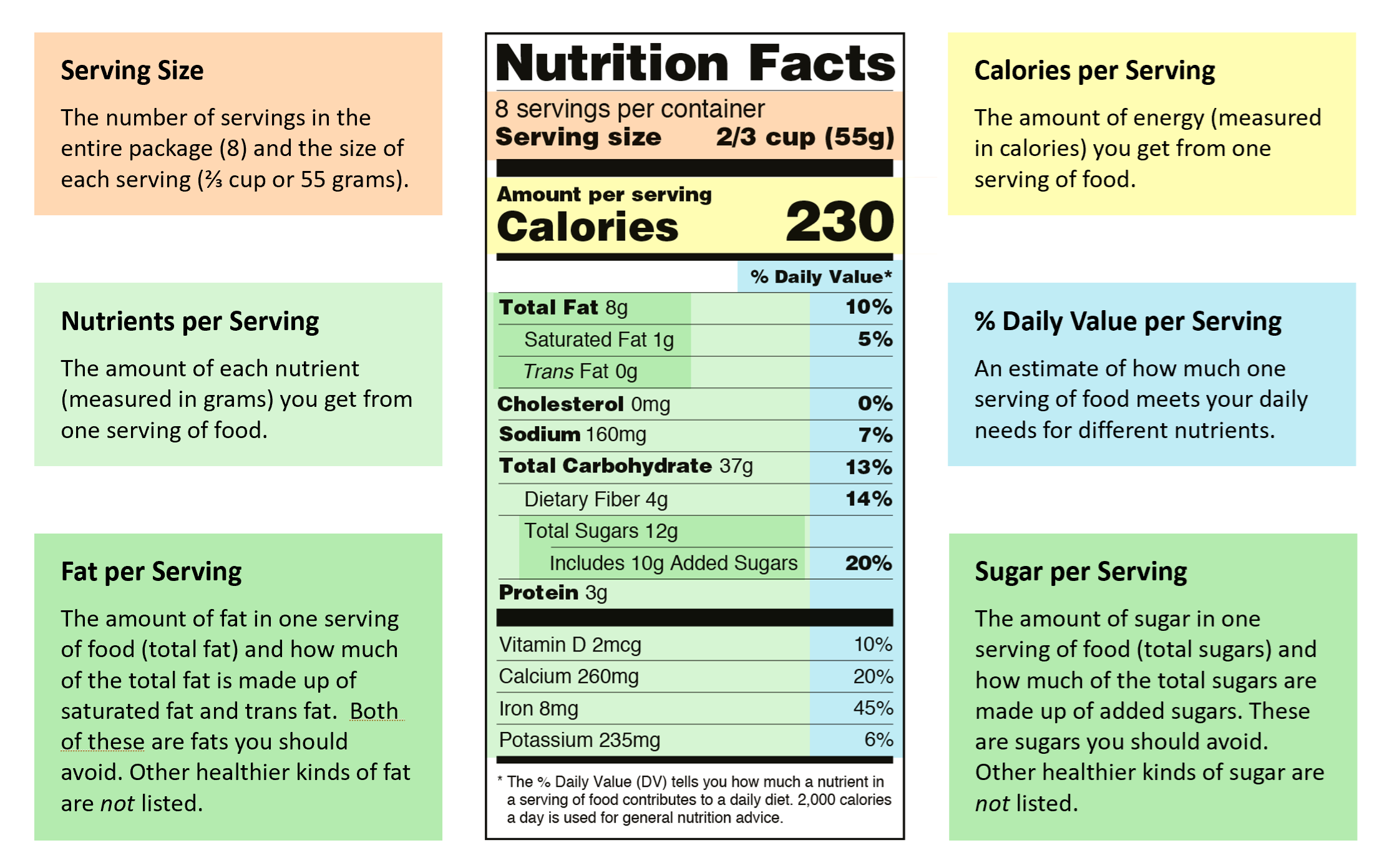Nutrition labels provide information about the calories and nutrients in a food package. They can help you pick foods that meet your dietary needs.
Nutrition labels have information like:
- Serving size
- Calories
- Nutrients, including:
- Fat
- Cholesterol
- Sodium (salt)
- Carbohydrates (like fiber and sugar)
- Protein
- Vitamins (like vitamin C)
- Minerals (like iron)
- Percent daily value of nutrients

Serving Size
The serving size is the suggested amount for you to eat as one meal or snack. It also lets you know the amount of food with the nutrients outlined in the rest of the nutrition label. If you multiple the serving size by the number of servings, you get the amount of food in the whole container.
For example, say a snack bag of pretzels has 2 servings and each serving has 100 calories. But you usually eat the whole bag. You would be eating 200 calories of pretzels (2 servings x 100 calories). That means you would also be eating double the numbers of nutrients that are listed on the rest of the label.
Calories
Nutrition labels tell you the number of calories in one serving of food. Watching your calories is one way to help you stay at a healthy weight. Everyone is different, so everyone needs a different number of calories each day. Nutrition labels are based on a 2,000 calorie diet, but some people may need to eat more or less calories than that each day.
Nutrients
Nutrition labels list the amount of nutrients are in one serving of food. Different nutrients can be good or bad for you. Most people should limit saturated fat, trans fat, added sugar, and salt (sodium). Too much saturated fat and salt can increase your risk for heart disease. Too much sugar can increase your risk for conditions like diabetes.
Fat
Nutrition labels tell you how much of all the fat in a food (total fat) is made up of saturated fat and trans fat. Both of these are fats you should avoid. On the label above, there are 8 grams of total fat. 1 gram of that comes from saturated fat.
Some fats aren’t listed on nutrition labels. These are the kinds of fat that are part of a healthy diet. That’s why the percents on nutrition labels sometimes don’t add up, like on this label. The 7 grams of fat not listed come from healthier fat in this food.
Sugar
Just like fat, nutrition labels tell you how much of all the sugar (total sugar) in one serving of food is made up of added sugars. This is sugar that isn’t naturally found in food. It’s extra sugar added in during the production process. These are sugars you should avoid. On the label above label, there are 12 grams of total sugars. 10 grams of that comes from added sugars.
Nutrition labels don’t list natural sugars, like the sugar found in fruit. These are the kinds of sugar that are part of a healthy diet. That’s why the percents sometimes don’t add up, like on this label. The other 2 grams of sugar not listed come from healthier sugar in this food.
% Daily Value (%DV)
But how much of each nutrient should you eat in a day? The % daily value on the food label tells you this.
For the label above, the food has 8 grams of total fat which is 10% of the daily value. That means one serving of this food provides 10% (one tenth) of all the fat an average person needs in a day. This value is just an estimate. Like the rest of a nutrition label, it’s based on a 2,000 calorie diet.
If there is no % listed, that means there is no recommended amount to eat in a day. For example, most people don't need a certain amount of protein in their diet.
Read food labels and make healthy food choices!
.png)

